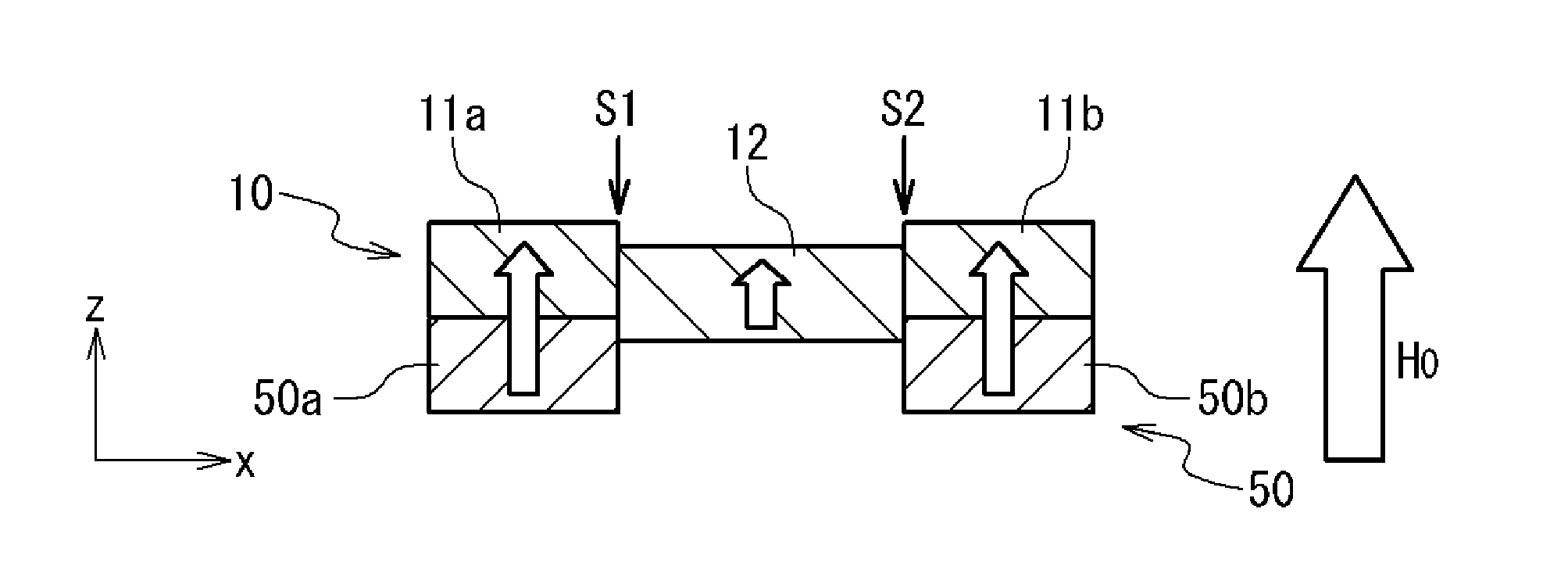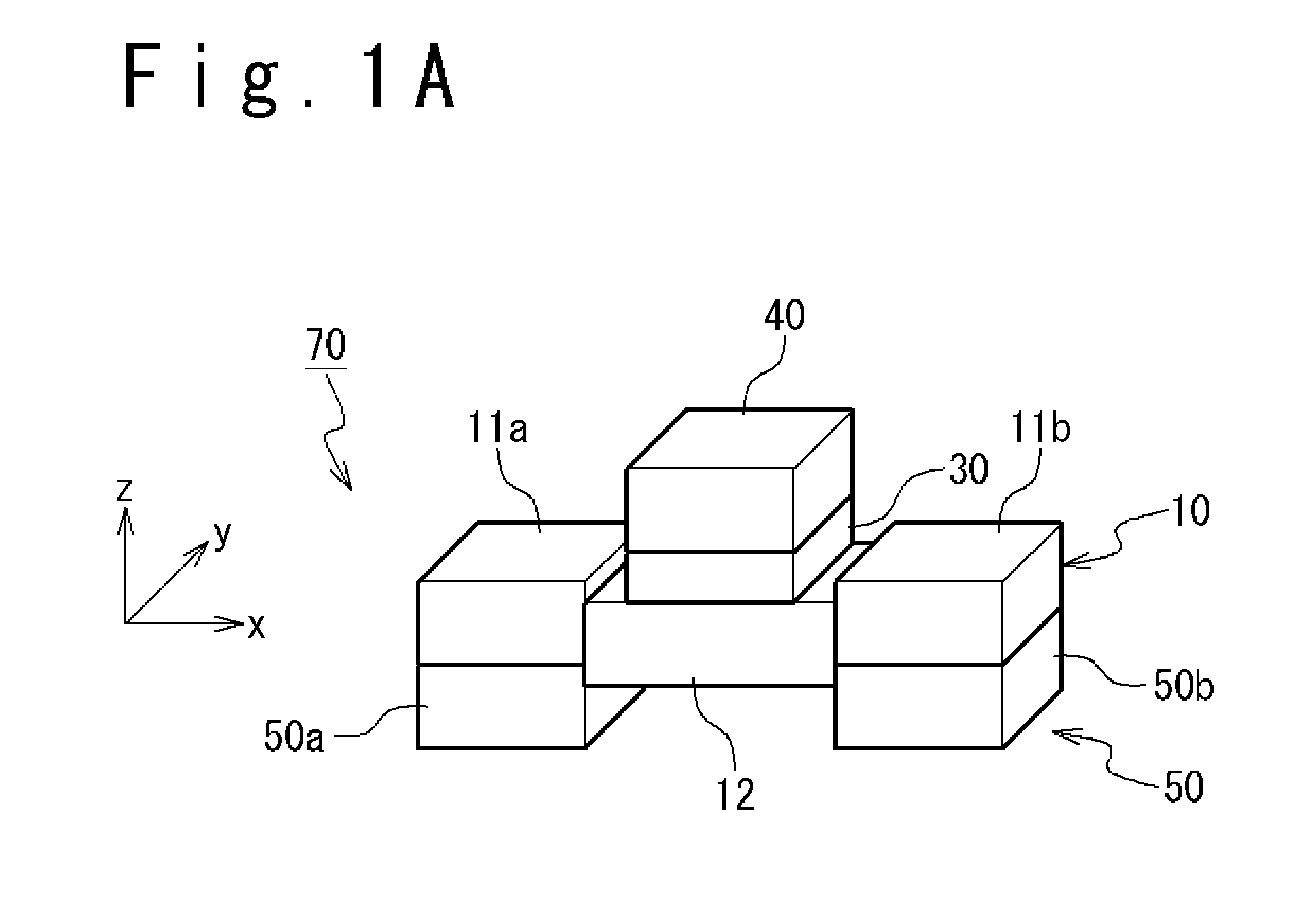Magnetic memory element, magnetic memory and manufacturing method of the same
a technology of magnetic memory and manufacturing method, which is applied in the direction of solid-state devices, semiconductor devices, instruments, etc., can solve the problems of difficult technique of patent literature 2 and achieve the effect of stably holding information
- Summary
- Abstract
- Description
- Claims
- Application Information
AI Technical Summary
Benefits of technology
Problems solved by technology
Method used
Image
Examples
first exemplary embodiment
1. Structure
[0076]FIGS. 1A, 1B and 1C schematically show a typical structure of a main portion of a magnetic memory element 70 according to a first exemplary embodiment of the present invention. FIGS. 1A, 1B and 1C show a perspective view, an x-z sectional view and an x-y plan view, respectively. Here, it is assumed that, in the x-y-z coordinate system shown in the drawings, the z axis is a direction perpendicular to the substrate, and the x axis and the y axis are directions parallel to the surface of the substrate (substrate surface). The magnetic memory element 70 includes a first magnetization free layer 10, a non-magnetic layer 30, a reference layer 40 and a step formation layer 50.
[0077]Specifically, FIG. 1C is the plan view schematically showing a structure of the first magnetization free layer 10. The first magnetization free layer 10 is composed of ferromagnetic material with perpendicular magnetic anisotropy. Further, the first magnetization free layer 10 included three re...
first modification example
11-1. First Modification Example
[0124]FIGS. 10A and 10B schematically show a structure of the first modification example of the magnetic memory element according to the first exemplary embodiment of the present invention. FIG. 10A shows the perspective view and FIG. 10B shows the x-z sectional view. The first modification example relates to the step shape.
[0125]In the present exemplary embodiment, in the first magnetization free region 10, the first step S1 is provided at the boundary between the first magnetization fixed region 11a and magnetization free region 12, and the second step S2 is provided at the boundary between the second magnetization fixed region 11b and the magnetization free region 12. In the example shown in FIGS. 1A to 1C, the height of the magnetization free region 12 is lower than the height of the first magnetization fixed region 11a and the height of the second magnetization fixed region 11b. However, the shape of the step is arbitrary. For example, as shown i...
second modification example
11-2. Second Modification Example
[0127]FIG. 11A schematically show structures of the second modification example of the magnetic memory element 70 according to the first exemplary embodiment of the present invention. FIG. 11A shows the perspective view and FIG. 11B shows the x-z sectional view. The second modification example relates to the material of the step formation layer 50, the initialization method, and the method of fixing the magnetization of the first magnetization fixed region 11a and the second magnetization fixed region 11b.
[0128]In the present exemplary embodiment, the first magnetization free layer 10 includes: the first magnetization fixed region 11a, the second magnetization fixed region 11b and the magnetization free region 12, and the magnetization of the first magnetization fixed region 11a and the magnetization of the second magnetization fixed region 11b are fixed such that they are anti-parallel to each other. Therefore, the initialization process is require...
PUM
| Property | Measurement | Unit |
|---|---|---|
| current | aaaaa | aaaaa |
| current | aaaaa | aaaaa |
| thickness | aaaaa | aaaaa |
Abstract
Description
Claims
Application Information
 Login to View More
Login to View More - R&D
- Intellectual Property
- Life Sciences
- Materials
- Tech Scout
- Unparalleled Data Quality
- Higher Quality Content
- 60% Fewer Hallucinations
Browse by: Latest US Patents, China's latest patents, Technical Efficacy Thesaurus, Application Domain, Technology Topic, Popular Technical Reports.
© 2025 PatSnap. All rights reserved.Legal|Privacy policy|Modern Slavery Act Transparency Statement|Sitemap|About US| Contact US: help@patsnap.com



